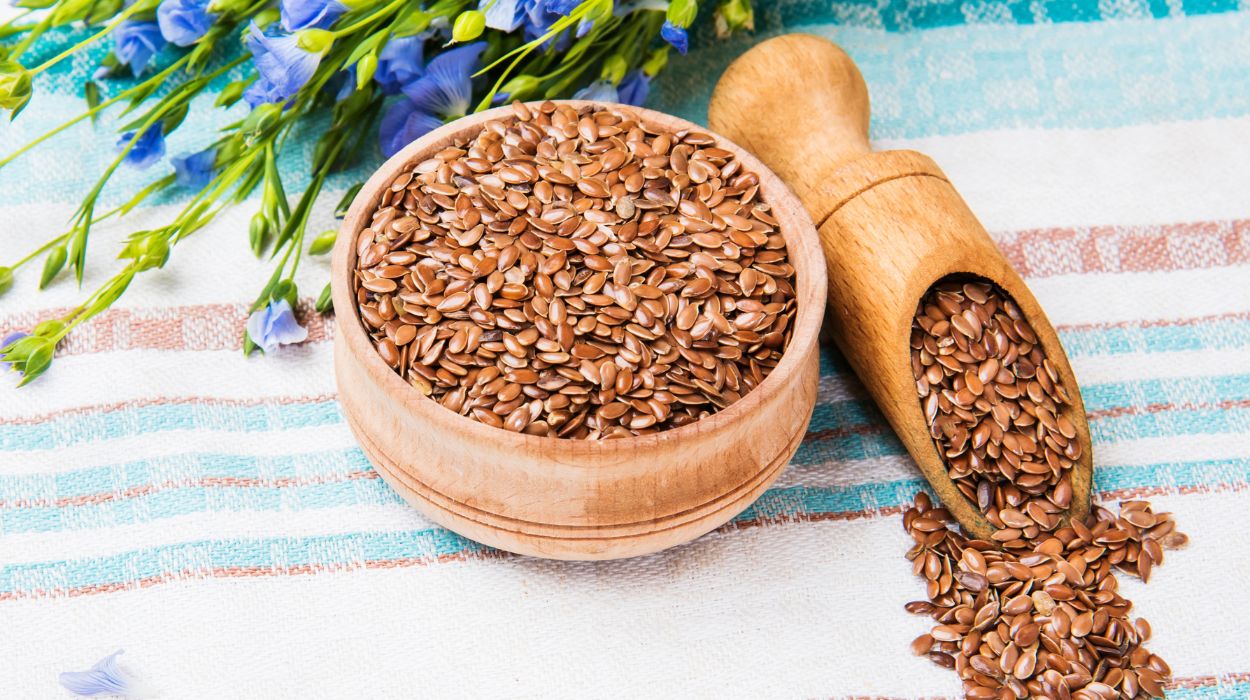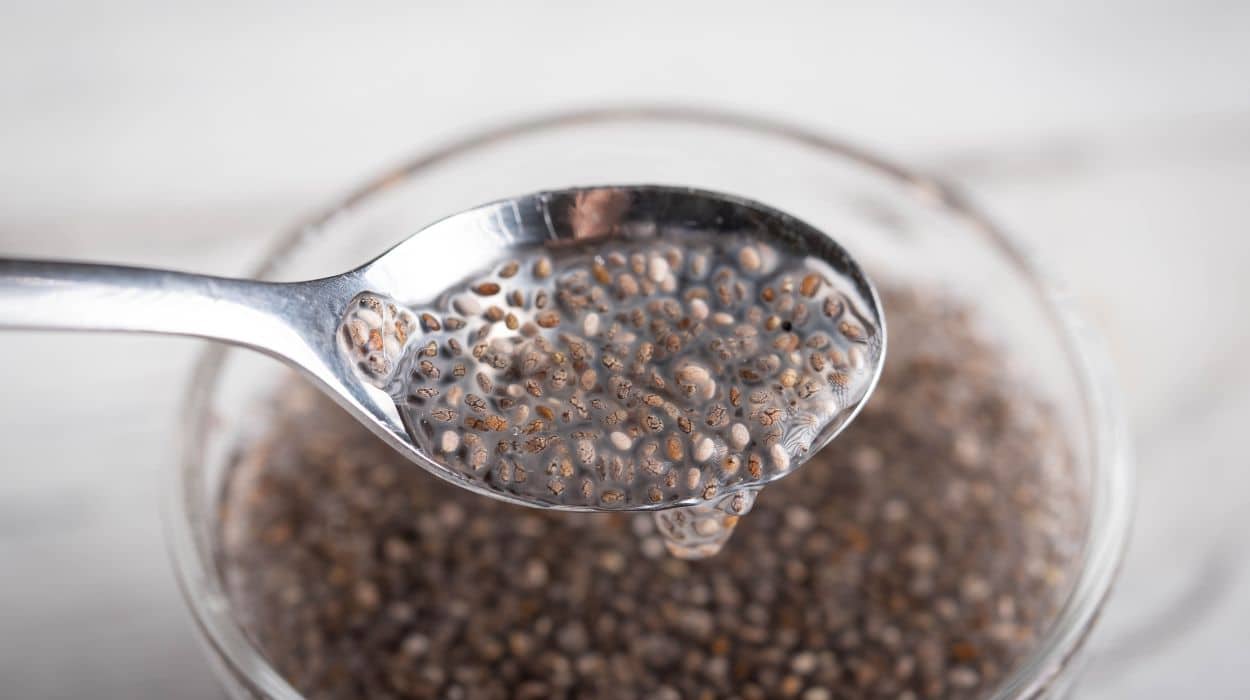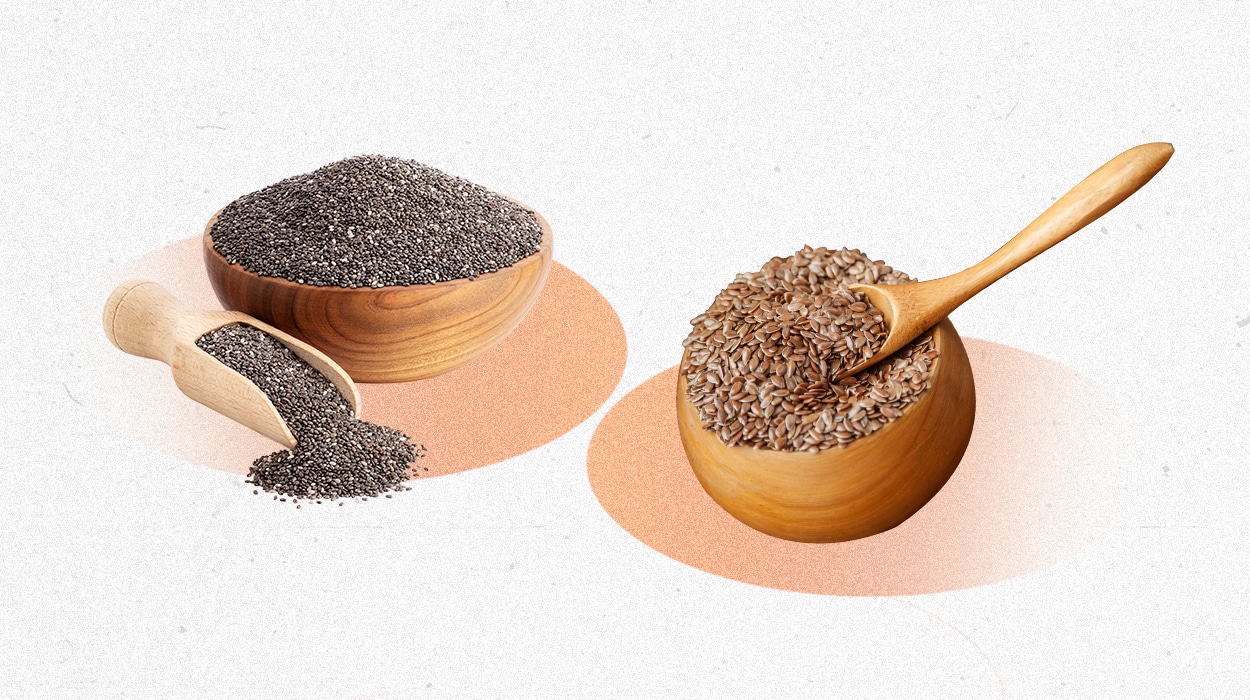Chia seeds and flax seeds are both tiny, fiber-packed seeds, making them ideal choices to bulk up the fiber in the diet. These tiny seeds are easily added and sprinkled into smoothies, oatmeal, salads, and other dishes. In addition to fiber, both chia and flax seeds offer essential omega-3 fatty acids, as well as other nutrients. Let’s look at more of their traits, including what sets them apart.
Chia Seeds Vs. Flax Seeds: What Are The Differences?
Chia seeds are tiny oval seeds, which come in black, brown, and white colors. Flax seeds are brown, almond-shaped, slightly bigger, but still very small. Flax seeds are not well-absorbed in the body when ingested whole, so many people around buy them pre-ground. Chia seeds have slightly more calories, fiber, fat, and protein than flax seeds, however, both are excellent sources of nutrients, and both can offer similar health benefits.
Flax Seed Vs. Chia Seed: Significant Features Of Nutritional Content
Ounce for ounce, let’s compare ground flax seed to chia seed. In two tablespoons of seeds, you get
Fiber
11 grams of fiber (chia seed)/4.2 grams of fiber (flax seed)
Fat
7 grams of fat (chia seed)/6.3 grams of fat (flax seed)
Protein
4.4 grams of protein (chia seed)/2.76 grams of protein (flax seed)
Calories
140 calories (chia seed)/78 calories (flax seed)
Additionally, chia seeds contain 18% of the daily recommended amount of calcium, as well as contain other minerals, such as copper, magnesium, zinc, and potassium, and are a good source of omega-3s. Ground flax seeds contain similar minerals and are also a good source of folate. In fact, though it would appear that there are higher amounts of nutrients in chia seeds, this does not necessarily mean that whole flax seeds are any less healthy – it just depends on what your body needs.
What Are Chia Seeds?
Chia seeds are small, oval-shaped seeds that come from the Salvia Hispanica plant in the mint family, which grows natively in parts of central and southern Mexico. Chia seeds are one of the smallest existing seeds (measuring about two millimeters) and have been said to be part of the ancient Aztecs’ diet. Within their tiny frame, chia seeds offer a substantial amount of protein, omega-3, and fiber, as well as iron, calcium, zinc, and magnesium. Chia seeds are easy to add to any meal because they are relatively tasteless.
What Are Flax Seeds?

Also called linseeds, are native to the Middle East and are also very small–but not as small as chia seeds. Flax seeds are almond-shaped seeds, that contain many phytonutrients, including fiber, various minerals, as well as essential healthy fats and protein. Flax seeds have been touted for improving many health conditions, thanks to their dense nutrient profile. Flaxseeds help to spruce up salads and oatmeal thanks to their earthy, nutty flavor.
Benefits Of Flax Seeds Vs. Chia Seeds
Protect Against Certain Cancers
Fiber has been linked to reduced risk of cancer in several ways, and the insoluble fiber in both chia and flax seeds in particular may be beneficial in protecting against breast cancer and colon cancer. In addition to fiber, chia, and flax seeds are filled with antioxidants, powerful fighters against free radicals which damage cells–the type of damage that leads to premature aging and disease development. Flax seeds are particularly high in these antioxidants, which makes them beneficial for protecting against certain cancers.
Help Lower Risk For Heart Disease
Omega-3s are great for the heart, and good sources of them are flax and chia seeds. In particular, ALA (alpha-linolenic acid) is a type of omega-3 fat that comes from plants, rather than animals, and both flax seeds and chia seeds have ALA. This type of fat is especially important to consume because, unlike other vitamins and minerals, the body is unable to make it on its own – it needs to come from your diet. The ALAs in chia and flax seeds have been correlated with a lowered risk of heart disease, and it’s been shown that these seeds can also help to reduce cholesterol and blood pressure, which, if too high, could pose a risk for heart disease.
Help Lower Blood Sugar
Fiber is the keyword in all things health, and that includes blood sugar stabilization. Both chia and flax seeds come packed with fiber, which allows sugar to be absorbed more slowly in the body, leading to less blood sugar spikes, and less excess glucose floating around in the bloodstream. For this reason, it’s encouraged to never eat carbs, sugar, or fruit alone, but rather, to pair them with a source of fiber. So, be liberal with your seeds – add them to yogurt, oatmeal, and anything else you can think of!
Curb Hunger And Appetite
It’s no surprise, that fiber is non-negotiable when it comes to maintaining satiety, thereby reducing appetite, cravings, and excessive snacking. Both chia seeds and flax seeds have lots of fiber which helps curb hunger and cravings. Flax seeds tend to have a little more soluble fiber,[1] a type of fiber that gets “sticky” when mixed with water. This sticky fiber helps to slow digestion, leaving you feeling fuller for longer.
Improve Digestion
The soluble fiber in both chia and flax seeds makes a sticky, gel-like consistency when mixed with water in the digestive process, which not only helps with satiety but also can help relieve constipation.[2] Regular elimination is necessary for healthy digestion. Additionally, both seeds help to encourage the growth of beneficial bacteria in the gut microbiome.
Improve Brain Health
Anything in the nut and seed family is known as a “brain food” due to its cognitive-boosting nutrients. The omega-3s in flax and chia seeds do wonders to curb inflammation and reduce stress, including inflammation in the brain. In fact, certain mental health conditions, such as ADHD, depression, and others have been linked to deficiencies in omega-3 fatty acids. The fiber, folic acid, vitamin B6, and other nutrients in the seeds serve to further assist in better brain function.
Chia Seeds Vs. Flax Seeds: How To Use & Eat

Ground The Seeds
You can eat chia seeds whole, however, flax seeds should be ground in order for the body to digest them properly and extract the nutrients. To do this, put the seeds in a coffee grinder and then sprinkle the ground seeds into whatever dish you choose. You can also purchase them pre-ground.
Sprinkle In Oatmeal
Nothing livens up the taste and texture of oatmeal more than seeds! Next time you’re making your morning bowl of oatmeal, consider sprinkling in some flax seeds, chia seeds, or both!
Add To Smoothies
If you don’t like the taste of seeds but want the health benefits, try adding them to a smoothie. Just throw the seeds in the smoothie, blend, and you won’t even know they’re in there!
Sprinkle On Salad
Need a little crunch to your salad? Skip the croutons and add some seeds instead.
Make Chia Pudding
Mix one tablespoon of chia seeds with one cup of plant milk (oat, almond, cashew, rice, etc.) and let it sit for 15-20 minutes. It will turn gelatinous and creamy chia pudding. From there, add whatever fruit and seasoning you like!
Make Chia Seed Water
Boosts your dietary fiber and hydration in one go! Add a spoonful of chia seeds to a bottle or glass of filtered water. This will allow you to get all the nutritional benefits from the seeds, while also getting the necessary hydration to go with a fiber increase.
Conclusion
Both chia and flax seeds provide similar nutrients and health benefits, even though they come from different plants grown in different regions around the world. Depending on your personal health goals, you may find chia seeds more healthful than flax, or vice versa. Regardless of which you prefer or need, they’re both easily assimilated into most diets and are well tolerated by many people.
Frequently Asked Questions
They are both healthy and each provides similar amounts of nutrients, however, you may want to incorporate one more than the other depending on which nutrient you’re looking to focus on specifically. The question is really, which one is healthier for you?
No, chia seeds can be eaten whole, while flax seeds should be ground.
It’s hard not to like the taste of chia seeds because they are relatively tasteless. However, flax seeds have a nutty flavor that some people may not like. If this is the case, try sprinkling a little into oatmeal or a smoothie where the taste will be covered by the other ingredients.
 Expert's opinion
Expert's opinion
